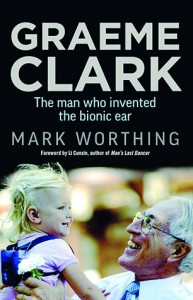In this inspiring biography, Mark Worthing takes us on a journey through the life and achievements of committed Christian and scientific pioneer, Professor Graeme Clark.
Setting the scene of humility and warmth, the book starts with Mark recounting his visit to the Clarks’ home. We get a sense of home. Of normality. Of the ordinary amid the extraordinary. A modest mudbrick home, surrounded by natural scrub. An old pottery kiln in the backyard. Biscuits and sandwiches. And choosing outfits for a trip to Canberra to meet Prince Charles and the Duchess of Cornwall. Extraordinary indeed.
This biography takes us through Graeme’s childhood in Camden, New South Wales, where his interest in “fixing ears” was highly influenced by the experience of his father’s hearing loss. We learn about boarding school, meeting his wife, Margaret, and then marriage, overseas study, resettling in Australia, and starting a family. We get a sense of Graeme the man, and his love for his family and enjoyment spent playing with his young children. The book includes photo memories of Graeme’s childhood, young adulthood, family life and momentous occasions of his professional career.
We also get a thorough sense of Graeme Clark, Australia’s youngest professor of medicine, who faced setbacks and plenty of opposition from academics and scientists in the field. We gain insight into his genuine and holistic care for patients. And his integrity as he refused to rush his science. Thoroughness and attention to detail contributed greatly to his success. This biography provides a comprehensive insight into what it took for Graeme and his team to develop the bionic ear; achieving his ultimate aim of enabling the profoundly deaf to hear.
This is a candid account of Graeme’s life and achievements, and does not shy away from his moments of failure. Such experiences did not deter him. He pressed on. And he ultimately achieved what others had tried and failed, and what many others told him was not possible.
 A memorable part of this book for me was reading about a moment of profound serendipity that occurred while Graeme was relaxing on the beach with his family. This moment involved a turban shell (the structure of which remarkably resembled the human inner ear) and a blade of grass. It led to a timely breakthrough which had, up until that point, puzzled his research team. Some of our best ideas come to us at the most unexpected and unplanned times!
A memorable part of this book for me was reading about a moment of profound serendipity that occurred while Graeme was relaxing on the beach with his family. This moment involved a turban shell (the structure of which remarkably resembled the human inner ear) and a blade of grass. It led to a timely breakthrough which had, up until that point, puzzled his research team. Some of our best ideas come to us at the most unexpected and unplanned times!
This book also speaks of Graeme’s deep and steadfast relationship with God; a source of great strength throughout his life. We learn about Graeme’s humility in seeking God in prayer and quiet reflection before performing surgery. On faith and science, Mark writes:
“… While many in the community are under the impression that science and personal faith in God are at odds with one another, Graeme saw encouragement in the sciences for his faith. In fact, he felt that recent advances in scientific knowledge actually made faith easier, or at least helped to give it intellectual credibility … The more he saw … the wonder of human hearing and the human brain, the wonder of nature in all its grandeur, the more he sensed the presence of a loving God” (p. 141-142).
If you enjoy reading about real people behind titles and accolades, you will enjoy reading this biography. It provides detailed insight into the life of a pioneering scientist, at the same time allowing the reader to identify with Graeme as a person – a son, a brother, a husband, a father. A man of great faith and humility, who actively seeks God and lives his faith.
Belinda Garth is a Research Fellow at Southern General Practice Training in Gippsland, Victoria, is a member of ISCAST (Christians in Science), has been a lecturer at La Trobe University and has worked on research projects with The University of Sydney, The University of Melbourne, Monash University, and Charles Drew University of Medicine and Science (Los Angeles). Belinda is a wife and mother of three.
Email This Story
Why not send this to a friend?
